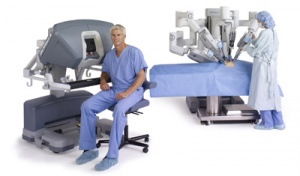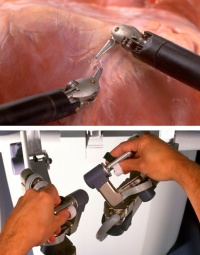Da Vinci Surgical System
Da Vinci Surgical System is a system that performs minimally invasive surgery with robotic assistance. The Da Vinci was created by Intuitive Surgical and was one of the first robotic surgical system to be approved by the Food and Drug Administration (FDA). The Da Vinci has been famed for its increased precision and enhanced range of motion in comparison to open surgery. Within the last 14 years, around 4,500 of these systems have been installed and 1.75 million of these robotic procedures have been performed in the United States. [1]:
Contents
History
The first notion of robotic surgery was developed by National Aeronautics and Space Centre(NASA) in the 1980s.[2] Commercialization of these robotic surgical system began in the early 1990s, leading to the introduction of both Zues robotic system by Computer Motion and Da Vinci robotic system by Intuitive Surgical. Intuitive Surgical bought out Computer Motion in 2003 and now remains the only company to commercialize these robotic surgical systems. In 2000, the Da Vinci became the first system to be approved by the FDA and has flourished in the surgical field ever since.
System Overview
System Components
The system consists of two separate consoles the robotic cart and the surgeon console. The robotic cart consists of three to four robotic arms. Attached to two robotics arms are the EndoWrist instruments which provides degrees of directional motion similar to the human hand. This is an increased range of motion compared to traditional laparoscopic surgeries allowing for greater maneuverability. [2] Attached to the third arm is a laparoscopic camera that provides visual feedback to the surgeon console.
All operations of the robotic cart are controlled by the surgeon console which can be located within the operating room or in a remote location. The surgeon's console is where the surgeon sits and is provided with high quality 3D visual feedback. He or she is able to control the separate robotic console with the use of hand manipulators and foot pedals. The movements of the surgeons hands are translated into the computer which then moves the wrist instruments. This movement is scaled up by ten folds allowing for increased precision. Precision is also enhanced by the systems ability to correct for tremors in hand movements.[3]
Training
The Da Vinci system requires extensive training because the system provides no form of haptic feedback, every instinct is learned through visual perception. Intuitive Surgical teams up with each hospital to run surgeons through four phases of training:[4]
- Phase 1: Introduction to da Vinci (Product Training)
- Phase 2: Da Vinci Technology Training (Product Training)
- Phase 3: Initial Case Series Plan (Skills Application)
- Phase 4: Continuing Development (Skills Application)
Each hospital varies in how each candidate is given credentials or privileges.
Procedures
Types of surgeries that have been approved by the FDA and can be completed with the Da Vinci[5]
- Cardiac Surgery
- Colorectal Surgery
- General Surgery
- Gynecologic Surgery
- Head & Neck Surgery
- Thoracic Surgery
- Urologic Surgery
Patient Advantages
The Da Vinci surgical system creates many benefits for patients. The increased precision of the surgeon allows for less trauma to the patient's body. Benefits of the Da Vinci as compared to open surgery include shorter hospital stays, less pain, less blood loss, and less scaring.[3]
Patient Risks
The normal risks possible with any surgical procedure are also associated with the Da Vinci, however the system also contains various other added patient risks. Research has shown there is a number of technical difficulties and complications that still occur during these robotic procedures. Over a 14 year period, the number of injuries and death events were recorded and results stayed around 83.4 events for every 100,000 procedures performed. [1] Device and instrument malfunctions made up a majority of these reports. A few of the most common device malfunctions were parts falling off into patients' bodies, electric arcing of instruments, and unintended movement while operating.[6] Aside from technical difficulties, there have also been several lawsuits filed in association with patient injury due to lack of surgeon training on the systems. [7]
Costs
The average unit cost per machine is $1 to $2.5 million. On a procedural basis, the Da Vinci surgery is an additional $1,600 more than the general procedure without robotic assistance, this is about a 6% increase. [8] Most insurance companies do not reimburse at higher rates for these robotic assisted procedures like they would for the general procedure.
Contrasting Opinions[9]
Many people believe that robotic surgeries are the way of the future. In fact, the hype surrounding these robotic systems is so large that one of the companies that produces these robotic surgery systems posted a $670 million revenue, beating investor expectations, largely due to their production of robotic surgery systems. These systems have been received well because the robotic arms can get into hard-to-reach places, promising patients less bleeding, faster recovery, less chance of damage to important nerves, and smaller scars than traditional surgeries.
However, many believe that the Da Vinci system is “a solution in search of a problem”:
- One of the biggest criticisms has been that the Da Vinci has not improved patient outcomes as dramatically as the first invention of minimally invasive surgery did. After 15 years of use, the Da Vinci system lacks any evidence that it is better than other less expensive methods. A surgery completed with the Da Vinci robot costs approximately 10x more than a laparoscopic surgery and so many doctors think that it should do a lot better overall, and yet the results don’t stand up to the price hike.
- The Da Vinci was originally designed for cardiovascular surgery but it has fallen out of favor for heart surgeries. It was then picked to do gynecological surgeries but by 2013, the American College of Obstetricians and Gynecologists said that it was not the best, or even the second best, option for gynecological surgeries. A surgery utilizing the Da Vinci system costs approximately $3000 more than a comparable laparoscopic surgery for removing ovarian cysts.
It seems that the Da Vinci found its calling removing prostates. Prostate removals are hard to do laparoscopically and so many surgeons had to use incisions. The Da Vinci system made it much easier to do these removals in a minimally invasive way and now nearly 90% of prostatectomies are done robotically. A study was done comparing the two types of surgeries and it found that patients who underwent prostatectomies that were completed robotically spent less time in the hospital recovering.
Future of Robotic Surgery
The future for the Da Vinci Surgical System focuses on its ability to perform remote telesurgery. This allows surgeons to perform surgeries on patients that are hundreds of miles away. In 2001, Dr. Jacques Marescauz was the first to perform gall bladder surgery in New York on a patient in Strasbourg, France.[10] In 2008, clinical research was performed to analyze the Da Vinci's ability to perform over a virtual private network spanning across 2848 km. The results showed a clear demonstration of the feasibility of the Da Vinci's ability to perform remote telesurgery.[11]
References
- ↑ 1.0 1.1 Alemzadeh, Homa et al. “Adverse Events in Robotic Surgery: A Retrospective Study of 14 Years of FDA Data.” Ed. Hyun-Sung Lee. PLoS ONE 11.4 (2016): e0151470. PMC. Web. 20 Feb. 2017.
- ↑ 2.0 2.1 Schreuder, H. and Verheijen, R. (2009), Robotic surgery. BJOG: An International Journal of Obstetrics & Gynaecology, 116: 198–213. doi:10.1111/j.1471-0528.2008.02038.x
- ↑ 3.0 3.1 Robotic Surgery. Mount Carmel Health System, n.d. Web.
- ↑ "Da Vinci® Training." Intuitive Surgical - Training. N.p., n.d. Web. 19 Feb. 2017.
- ↑ "The Da Vinci® Surgical System." Da Vinci Surgery - Minimally Invasive Robotic Surgery with the Da Vinci Surgical System. N.p., n.d. Web.
- ↑ Kirkpatrick, Tara, MD. "Robotic Surgery: Risks vs. Rewards." Robotic Surgery: Risks vs. Rewards | AHRQ Patient Safety Network. N.p., n.d. Web. 20 Feb. 2017
- ↑ Written by Cameron Scott | Published on August 10, 2016. "Is Da Vinci Robotic Surgery a Revolution or a Rip-off?" Healthline. N.p., 10 Aug. 2016. Web. 20 Feb. 2017.
- ↑ Barbash, Gabriel I., M.D., and Sherry A. Glied, PhD. "New Technology and Health Care Costs - The Case of Robot-Assisted Surgery — NEJM." New England Journal of Medicine. The New England Journal of Medicine, n.d. Web.
- ↑ http://www.healthline.com/health-news/is-da-vinci-robotic-surgery-revolution-or-ripoff-021215#2
- ↑ Marescaux, Jacques. "Transatlantic Robot-assisted Telesurgery." Nature. International Weekly Journal of Science, n.d. Web.
- ↑ Nguan, Christopher. "Pre-clinical Remote Telesurgery Trial of a Da Vinci Telesurgery Prototype." Wiley Online Library. THE INTERNATIONAL JOURNAL OF MEDICAL ROBOTICS AND COMPUTER ASSISTED SURGERY, n.d. Web. 20 Feb. 2017.

